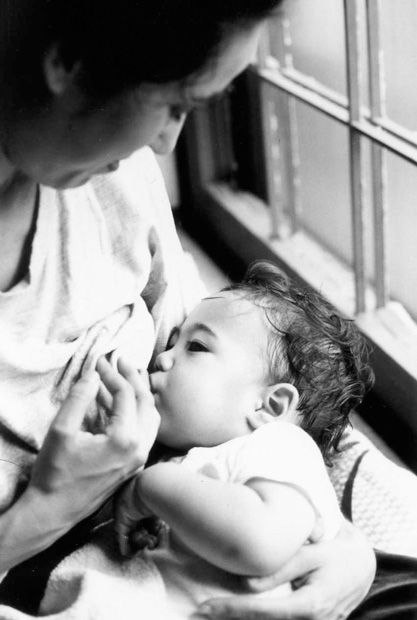by Brett Iimura and Iona Macnab
Breast-feeding is, of course, natural for mothers and babies, but it is a learned skill, and often help is needed to get things started properly. If breast-feeding can start off well, it usually means the baby will gain weight appropriately, and mother and baby can continue to breast-feed as long as they like. If breast-feeding gets off to a rough start, it may affect a mother’s confidence in her ability to nurture her baby, and she may feel she has no option but to use bottles and formula.
What do you need to know to get breast-feeding off to a good start?
1. All babies lose some weight after birth. This is normal. Babies are born with brown fat between their shoulders and around their internal organs, which is used for heat and energy, much like hibernating animals.
2. Babies need small, frequent amounts of colostrum, the first milk that all mothers have in their breasts, at birth. This is rich in antibodies and helps babies develop immunities. Just because you can’t see much of it, doesn’t mean it isn’t there!
3. A mother’s colostrum is all a baby needs in the first few days, no matter what size the baby was at birth. Some hospitals insist on supplementing babies with formula to increase their intake due to weight loss (see 1. above) or because the babies were very big at birth. But biologically speaking, new babies are not programmed for large quantities immediately, and their stomaches are not very elastic for the first few days. In addition, formula changes the lining of the baby’s stomach, making it more susceptible to pathogens and allergens. This is true even if the baby receives only one bottle of formula. So the choice to supplement should be taken in conjunction with skilled lactation help.
4. Babies need skin-to-skin contact with their mothers. How can a mother do this when her new baby is all bundled up in those cute hospital kimonos? You can take your baby’s clothes off (except for the diaper) and snuggle him or her onto your bare chest, then cover both of you with a blanket. Alternatively, you can just open the front of the kimono and have your baby snuggle in on your chest.
5. Babies have in-built reflexes which help them find the breast whether they are awake or in light sleep. If mothers and babies are always together after birth, then a mother can learn her baby’s signals for breast-feeding, even if the baby is not wide awake and not yet crying. Crying is the last sign of hunger, so having your baby close helps you learn the other earlier signs.
6. Mothers can help their babies to breast-feed by reclining back at an angle of about 45 degrees or so and allowing the baby to be upright between the mother’s breasts, at ‘kissing distance,’ (if the mother wanted to kiss her baby’s head, there it would be, right under her chin).
7. Babies can develop a preference for artificial nipples, such as bottle teats and pacifiers, if those items are used too soon, so avoiding them in the first few weeks is a good idea. If your baby needs extra milk, it can be fed by a sterile spoon or small cup.
8. A mother’s milk will become more copious about 72 hours after the birth. This is sometimes accompanied by fullness in the breasts, but using cool packs around the breasts between nursings and continuing to feed frequently is usually sufficient to give some relief.
How do you know if your baby is getting enough milk?
Watch baby during feeds to be sure he is swallowing; also check the baby’s diaper count. After the third day of life, a newborn should be wetting 5-6 diapers a day and passing stool at least twice a day, if not more. This is the most accurate way of knowing if breast-feeding is going well, and is more helpful to a mother than weighing the baby before and after each feed, which just serves to make a new mother anxious.
Breast-feeding should be a comfortable and enjoyable experience for both mothers and babies. If it isn’t, don’t hesitate to seek help!
Parenting tip:
La Leche League International (LLL) runs breast-feeding discussion groups with trained volunteer Leaders. Like Tokyo Weekender magazine, LLL has a long history in Tokyo, with English-speaking groups in Shibuya, Tachikawa and on the US military bases. There are also French and Japanese-speaking groups. Contact www.llli.org/Japan.html. Each group has a comprehensive library for members, and the leaders offer telephone and email support for new mothers for no charge.
Iona Macnab is an International Board Certified Lactation Consultant (IBCLC). She offers home visits, convenient Skype and webcam consultations, and prenatal breast-feeding workshops. Wherever you are in Japan or in the world, she is available online for breast-feeding assistance. For more information contact blue.sky@gol.com or visit www.blueskytokyo.com/consultation.html
——————————————————————————————————-
Brett Iimura ICCE, mother of two, is the director of the Childbirth Education Center (CEC), serving parents-to-be throughout Japan since 1997. Iona Macnab IBCLC is a lactation consultant in private practice in Tokyo and a mother of three. They have over thirty years of combined experience in Japan, and much experience raising bilingual, bicultural children!
Photos by Kazuhiko Iimura











